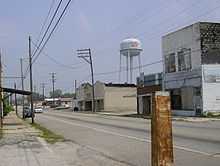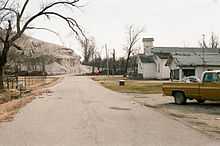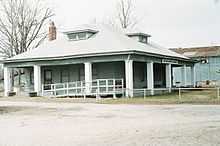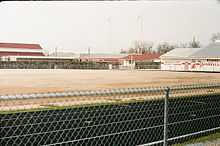Picher, Oklahoma
| Picher, Oklahoma | |
|---|---|
| Ghost town | |
 | |
| Coordinates: 36°58′58″N 94°49′58″W / 36.98278°N 94.83278°WCoordinates: 36°58′58″N 94°49′58″W / 36.98278°N 94.83278°W | |
| Country | United States |
| State | Oklahoma |
| County | Ottawa |
| Area | |
| • Total | 2.2 sq mi (5.8 km2) |
| • Land | 2.2 sq mi (5.8 km2) |
| • Water | 0.0 sq mi (0.0 km2) |
| Elevation | 820 ft (250 m) |
| Population (2010)[2] | |
| • Total | 20 |
| • Density | 9.1/sq mi (3.4/km2) |
| Time zone | Central (CST) (UTC-6) |
| • Summer (DST) | CDT (UTC-5) |
| ZIP code | 74360 |
| Area code(s) | 539/918 |
| FIPS code | 40-58550[3] |
| GNIS feature ID | 1096611[4] |


Picher is a ghost town and former city in Ottawa County, Oklahoma, United States. Formerly a major national center of lead and zinc mining at the heart of the Tri-State Mining District, over a century of unrestricted subsurface excavation dangerously undermined most of Picher's town buildings and left giant piles of toxic metal-contaminated mine tailings (known as chat) heaped throughout the area. The discovery of the cave-in risks, groundwater contamination and health effects associated with the chat piles and subsurface shafts—particularly an alarming 1996 study which showed lead poisoning in 34% of the children in Picher[5]—eventually prompted a mandatory evacuation and buyout (via eminent domain) of the entire township by the Environmental Protection Agency and the incorporation of the town (along with the similarly contaminated satellite towns of Treece and Cardin) into the Tar Creek Superfund site.
A 2006 Army Corps of Engineers study showed 86% of Picher's buildings (including the town school) were badly undermined and subject to collapse at any time.[6] An F4 tornado which destroyed or damaged 150 homes in May 2008 accelerated the exodus. The town ceased official operations on September 1, 2009 and the population plummeted from 1,640 at the 2000 census to just 20 at the 2010 census. As of January 2011, only six homes and one business remain, their owners having refused to leave at any price; the rest of the town's buildings (excepting designated historical structures) are scheduled to be demolished by the end of the year.
Picher is among a small number of locations in the world (such as Gilman, Colorado and Wittenoom, Western Australia) to be evacuated and declared uninhabitable due to environmental and health damage caused by the mines the town once serviced.
History
In 1913, as the Tri-State district expanded, lead and zinc ore were discovered on Harry Crawfish's claim and mining began. A townsite developed overnight around the new workings and was named Picher in honor of O. S. Picher, owner of Picher Lead Company. The city was incorporated in 1918, and by 1920, Picher had a population of 9,726. Peak population occurred in 1926 with 14,252 residents and was followed by a gradual decline due to the decrease in mining activity, leaving Picher with only 2,553 by 1960.[7]
The Picher area became the most productive lead-zinc mining field in the Tri-State district producing over $20 billion worth of ore between 1917 and 1947. More than fifty percent of the lead and zinc metal used during World War I were produced by the Picher district. At its peak over 14,000 miners worked the mines and another 4,000 worked in mining services. Many workers commuted by an extensive trolley system from as far away as Joplin and Carthage, Missouri.[7] Mining ceased in 1967 and water pumping from the mines ceased. The contaminated water from some 14,000 abandoned mine shafts, 70 million tons of mine tailings, and 36 million tons of mill sand and sludge remained as a huge environmental cleanup problem.[7] The area became part of the Tar Creek Superfund site.

On April 24, 2006, Reuters reported that Picher had been scheduled to be closed and residents removed. Due in large part to the removal of large amounts of subsurface material during mining operations, many of the city's structures have been deemed in imminent danger of caving in.[8]
The city's pharmacist, Gary Linderman was featured in the May 28, 2007, issue of People magazine in the Heroes Among Us article "Prescription for Kindness". He vowed to stay as long as there was anyone left who needed him and to be the last one out of the city.[9]
Tornado
On May 10, 2008, Picher was struck by an EF4 tornado. There were eight confirmed deaths, possibly including one child, and many other injuries.[10] The tornado first touched down near the Kansas-Oklahoma border in Oklahoma southwest of Chetopa, Kansas, and tracked eastward. It then slammed into Picher with devastating results. Twenty blocks of the city suffered extensive damage with houses and businesses destroyed or flattened. The damage in Picher was rated at "EF4". At least 150 others were injured in Picher alone. The tornado continued eastward, passing just north of Quapaw and Peoria before crossing Interstate 44 into Missouri. The federal government also decided that there would be no aid given to rebuild homes, but the buyouts would continue as previously scheduled and people will be assisted in relocation.[11]
Oklahoma Governor Brad Henry sent National Guard troops as well as emergency personnel to assist the hardest hit area in Picher; twenty blocks which suffered major damage including several destroyed structures. Damage was reported in Peoria and Quapaw.[12]
Loss of power from the tornado forced the city to go on a boiled water notice. Staff from the Oklahoma Rural Water Association arrived to assist, since the utility's testing equipment was destroyed by the storm. With an emergency generator to supply power, rural water staff had the system running normally only two days after the tornado struck.[13]
Closure
In April 2009, residents voted 55–6 to dissolve the Picher-Cardin school district; it graduated its final class of 11 in May.[14] By 2009 the district's enrollment had dropped to a total of 49 students from approximately 340 three years prior. Remaining students will attend Commerce and Quapaw school districts.[15]

The city's post office was scheduled to close in July 2009 and the city ceased operations as a municipality on September 1, 2009.[16]
By June 29, 2009, all of the residents had been given federal checks to enable them to relocate from Picher permanently. The city is considered to be too toxic to be habitable. On the last day, all the final residents met at the school auditorium to say goodbye.[17] As of November 2010, it was reported that Picher still had "one business and six occupied houses."[18]
The people of the adjacent city of Treece, Kansas, saw the government carry out a similar relocation program in their city, too. On October 29, 2009, Congress voted to allow the EPA to fund the relocation of the remaining citizens of Treece.[5]
Starting in January 2011, almost all remaining commercial structures will be demolished, with the single exception of the Old Miner's Pharmacy, whose owner, Gary Linderman, refuses to abandon it.[19]
The municipality of Picher was officially dissolved on November 26, 2013.[20]
Geography
Picher is located at 36°58′58″N 94°49′58″W / 36.98278°N 94.83278°W (36.982824, -94.832777)[21]. According to the United States Census Bureau, the city had a total area of 2.2 square miles (5.7 km2), all of it land.
Demographics
| Historical population | |||
|---|---|---|---|
| Census | Pop. | %± | |
| 1920 | 9,676 | ||
| 1930 | 7,773 | −19.7% | |
| 1940 | 5,848 | −24.8% | |
| 1950 | 3,951 | −32.4% | |
| 1960 | 2,553 | −35.4% | |
| 1970 | 2,363 | −7.4% | |
| 1990 | 1,714 | ||
| 2000 | 1,640 | −4.3% | |
| 2010 | 20 | −98.8% | |
2000 census
As of the census[3] of 2000, there were 1,640 people, 621 households, and 417 families residing in the city. The population density was 734.0 people per square mile (283.9/km²). There were 708 housing units at an average density of 316.9 per square mile (122.6/km²). The racial makeup of the city was 77.13% White, 13.78% Native American, 0.18% Pacific Islander, 0.12% Asian, 0.06% from other races, and 8.72% from two or more races. Hispanic or Latino of any race were 1.40% of the population.
There were 621 households out of which 30.9% had children under the age of 18 living with them, 50.6% were married couples living together, 12.4% had a female householder with no husband present, and 32.7% were non-families. 29.1% of all households were made up of individuals and 14.0% had someone living alone who was 65 years of age or older. The average household size was 2.58 and the average family size was 3.20.
In the city the population was spread out with 27.1% under the age of 18, 9.1% from 18 to 24, 24.0% from 25 to 44, 23.5% from 45 to 64, and 16.2% who were 65 years of age or older. The median age was 37 years. For every 100 females there were 95.2 males. For every 100 females age 18 and over, there were 90.0 males.
The median income for a household in the city was $19,722, and the median income for a family was $25,950. Males had a median income of $22,321 versus $15,947 for females. The per capita income for the city was $10,938. About 21.1% of families and 25.4% of the population were below the poverty line, including 27.4% of those under age 18 and 30.9% of those age 65 or over.
Documentary film
Picher was featured in the PBS Independent Lens film The Creek Runs Red discussing the connection of the people and their desire to leave or stay in the city.[22] Picher was also featured in the Jump the Fence Productions film titled Tar Creek. The film, which was written, directed, and narrated by Matt Myers, features music from Blues legend Watermelon Slim.[23]
Picher was featured in an episode of Life After People: The Series on the History Channel.[24] The aforementioned tornado was also featured on an episode of the Weather Channel's Storm Stories.
Notable people
- Joe Don Rooney, country musician with the band Rascal Flatts.[25]
- Tim Spencer, singer and songwriter for Sons of the Pioneers and actor
See also
- Asarco, operated in Picher as "Federal Mining and Smelting Company"
- Treece, Kansas
- National Register of Historic Places listings in Ottawa County, Oklahoma
References
- ↑ Oklahoma State Historical Society National Register Listing,http://digital.library.okstate.edu/encyclopedia/entries/P/PI002.html
- ↑ "2010 City Population and Housing Occupancy Status". U.S. Census Bureau. Retrieved March 26, 2012.
- ↑ 3.0 3.1 "American FactFinder". United States Census Bureau. Retrieved 2008-01-31.
- ↑ "US Board on Geographic Names". United States Geological Survey. 2007-10-25. Retrieved 2008-01-31.
- ↑ 5.0 5.1 Treece Journal: Welcome to Our Town. Wish We Weren’t Here. Susan Saulny, The New York Times, September 13, 2009
- ↑ http://www.environment.ok.gov/documents/TarCkLICRAT/Other_PicherSubsidenceRpt_Rv14.pdf
- ↑ 7.0 7.1 7.2 http://digital.library.okstate.edu/encyclopedia/entries/T/TR014.html TRI-STATE LEAD AND ZINC DISTRICT, Oklahoma Historical Society
- ↑ Gillam, Carey. - "FEATURE-Slow death consumes Oklahoma mining town" - Reuters - April 24, 2006
- ↑ Heroes Among Us: "Prescription for Kindness" - People Magazine - May 28, 2007
- ↑ "Six Dead, 150 Injured After Tornado Levels Town Of Picher". KTUL. Archived from the original on 2008-05-14. Retrieved 2008-05-11.
- ↑ Evans, Murry. - Weather: "Rebuilding unlikely in Okla. town". - Associated Press. - (c/o MSNBC.com) - May 13, 2008
- ↑ "Tornado Death Toll Increases In Picher". - KOTV.com - May 12, 2008
- ↑ "Rural Water assists Picher after tornado strikes". National Rural Water Association. 2008. Retrieved 2008-05-23.
- ↑
- ↑ "In brief: Vote marks end for Picher school". NewsOK.com. Retrieved December 19, 2012.
- ↑ Sheila Stogsdill, "Picher projects its end as official municipality", Tulsa World, June 23, 2009.
- ↑ "'Last man standing' at wake for a toxic town - CNN.com". CNN. June 30, 2009. Retrieved May 22, 2010.
- ↑ Sheila Stogsdill, "Cardin population drops to 0 as buyout completed", Tulsa World, November 17, 2010.
- ↑
- ↑ UPI, December 4, 2013.
- ↑ "US Gazetteer files: 2010, 2000, and 1990". United States Census Bureau. 2011-02-12. Retrieved 2011-04-23.
- ↑ "The Creek Runs Red" - Independent Lens - PBS
- ↑ "Tar Creek" - Jump the Fence Productions
- ↑ Kennedy, Wally (January 11, 2010). "Filmmakers find stories in Picher". The Joplin Globe. Retrieved January 13, 2010.
- ↑ "Joe Don Rooney Biography". AOL. AOL Music. Retrieved 2008-05-16.
Further reading
- "Pollution brings end to Oklahoma mining town". msnbc.com. Microsoft. May 12, 2008. Retrieved October 7, 2009.
- "EPA/HUD Joint Statement on the Picher, Oklahoma, Housing Authority". Environmental Protection Agency. January 26, 2009. Retrieved October 7, 2009.
- Robertson, David, Hard as the Rock Itself: Place and Identity in the American Mining Town, ISBN 978-0-87081-850-9 (hardcover:alk.paper) ISBN 0-87081-850-3 HD 95483t65r632006 307376'60973-dc22, The University Press of Colorado 55890 Arapahoe Avenue, Suite 206c, Boulder, Colorado 80303
- http://www.upcolorado.com/bookdetail.asp?isbn=978-0-87081-850-9
- Tar Creek documentary website
- Paynter, Ben (August 30, 2010). "Welcome to Armageddon, USA: A Tour of America’s Most Toxic Town". Wired Magazine. Retrieved 20 September 2010.
External links
| Wikimedia Commons has media related to Picher, Oklahoma. |
| |||||||||||||||||||||||
